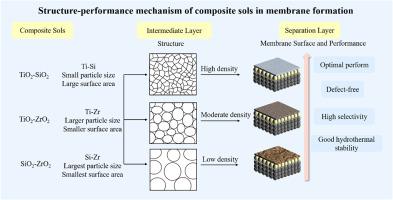Intermediate layer engineering with composite sols for enhanced separation efficiency and hydrothermal stability of 1,2-bis(triethoxysilyl)methane-derived hybrid silica membranes
IF 4.7
3区 材料科学
Q1 CHEMISTRY, APPLIED
引用次数: 0
Abstract
Organic-inorganic hybrid silica membranes, which combine the thermal stability of inorganic frameworks with the flexibility of organic groups, are promising for pervaporation applications. The intermediate layer, a crucial structural component bridging the particulate support and dense separation layers, plays a decisive role not only in governing the film-forming quality but also in determining interfacial compatibility and structural integrity. In this study, 1,2-bis(triethoxysilyl)methane (BTESM) was employed as the precursor to fabricate multilayer SiO2 hybrid membranes via the sol-gel method, with TiO2-SiO2, TiO2-ZrO2, and SiO2-ZrO2 composite sols introduced as intermediate layers. The effects on membrane microstructure, pervaporation performance, and hydrothermal stability were systematically investigated. Among the three systems, the TiO2-SiO2 derived membrane exhibited the highest performance, achieving a permeation flux of 0.88 kg m−2 h−1 and a separation factor of 1960 under optimized conditions of six coating cycles, 0.5 wt% sol concentration, and 550 °C calcination. It also showed excellent structural integrity during both hydrothermal treatment and long-term testing. Mechanistic analysis revealed that the formation of Ti-O-Si bridging bonds effectively inhibited grain growth and retarded the amorphous-to-crystalline transition, thereby stabilizing the intermediate layer structure and enhancing membrane robustness. This study establishes a structure-performance relationship for intermediate layer design and offers practical guidance for the development of durable, high-performance hybrid membranes in industrial pervaporation processes.

复合溶胶中间层工程研究1,2-双(三乙氧基硅基)甲烷衍生杂化二氧化硅膜的分离效率和水热稳定性
有机-无机杂化二氧化硅膜结合了无机骨架的热稳定性和有机基团的灵活性,在渗透汽化应用中具有广阔的前景。中间层是连接颗粒支撑层和致密分离层的关键结构组分,不仅对成膜质量起决定性作用,而且对界面相容性和结构完整性起决定性作用。本研究以1,2-二(三乙氧基硅基)甲烷(BTESM)为前驱体,以TiO2-SiO2、TiO2-ZrO2和SiO2- zro2复合溶胶为中间层,采用溶胶-凝胶法制备了多层SiO2杂化膜。系统研究了对膜微观结构、渗透汽化性能和水热稳定性的影响。其中,TiO2-SiO2衍生膜在6次涂布循环、0.5 wt%溶胶浓度、550℃煅烧条件下的渗透通量为0.88 kg m−2 h−1,分离系数为1960。在水热处理和长期测试中均表现出良好的结构完整性。机理分析表明,Ti-O-Si桥键的形成有效地抑制了晶粒的生长,延缓了非晶向晶的转变,从而稳定了中间层结构,增强了膜的坚固性。该研究为中间层设计建立了结构-性能关系,并为工业渗透蒸发过程中耐用、高性能杂化膜的开发提供了实践指导。
本文章由计算机程序翻译,如有差异,请以英文原文为准。
求助全文
约1分钟内获得全文
求助全文
来源期刊

Microporous and Mesoporous Materials
化学-材料科学:综合
CiteScore
10.70
自引率
5.80%
发文量
649
审稿时长
26 days
期刊介绍:
Microporous and Mesoporous Materials covers novel and significant aspects of porous solids classified as either microporous (pore size up to 2 nm) or mesoporous (pore size 2 to 50 nm). The porosity should have a specific impact on the material properties or application. Typical examples are zeolites and zeolite-like materials, pillared materials, clathrasils and clathrates, carbon molecular sieves, ordered mesoporous materials, organic/inorganic porous hybrid materials, or porous metal oxides. Both natural and synthetic porous materials are within the scope of the journal.
Topics which are particularly of interest include:
All aspects of natural microporous and mesoporous solids
The synthesis of crystalline or amorphous porous materials
The physico-chemical characterization of microporous and mesoporous solids, especially spectroscopic and microscopic
The modification of microporous and mesoporous solids, for example by ion exchange or solid-state reactions
All topics related to diffusion of mobile species in the pores of microporous and mesoporous materials
Adsorption (and other separation techniques) using microporous or mesoporous adsorbents
Catalysis by microporous and mesoporous materials
Host/guest interactions
Theoretical chemistry and modelling of host/guest interactions
All topics related to the application of microporous and mesoporous materials in industrial catalysis, separation technology, environmental protection, electrochemistry, membranes, sensors, optical devices, etc.
 求助内容:
求助内容: 应助结果提醒方式:
应助结果提醒方式:


